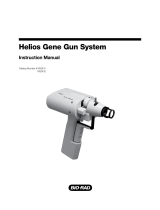Page is loading ...

DH5α Competent Cells
Catalog Number EC0112
Pub. No. MAN0018520 Rev. A.0
WARNING! Read the Safety Data Sheets (SDSs) and follow the handling instructions. Wear appropriate protective eyewear, clothing, and
gloves. Safety Data Sheets (SDSs) are available from thermosher.com/support.
Product description
Thermo Scientic™ DH5α Competent Cells are ideal for construction of gene banks or generation of cDNA libraries using plasmid-derived vectors.
The φ80dlacZΔM15 marker provides α-complementation of the β-galactosidase gene from pUC or similar vectors to allow blue/white colony
screening on bacterial agar plates containing Bluo-Gal or X-Gal.
Genotype
F– φ80lacZDM15 D(lacZYA-argF) U169 recA1 endA1 hsdR17 (rk–, mk+) phoA supE44 l– thi–1 gyrA96 relA1
Contents and storage
Contents Amount Storage
DH5α Competent Cells 10 × 100 µL −80°C (Do not store in liquid nitrogen)
pUC19 DNA (10 pg/µL) 50 µL −80°C
S.O.C. Medium 6 mL 4°C or room temperature
Guidelines for tranforming cells
• For best results, thaw each vial of cells only once. Subsequent
freeze-thaw cycles signicantly lower transformation eciency.
• Use S.O.C. Medium for the cell recovery procedures after heat
shock. Transformation eciency is reduced if other types of media
are used.
• Maximum transformation eciency is obtained with plasmid
DNA that is free of phenol, ethanol, protein, and detergents.
Transformation of unpuried sample DNA or ligation reactions
will result in slightly lower transformation eciencies.
• To determine the transformation eciency of the cells, perform a
control reaction using 10 pg (1 µL) of the pUC19 DNA stock
solution. Dilute pUC19 DNA control reaction 1:10 with S.O.C.
Medium immediately before plating. Spread 30 µL of the pUC19
DNA control reaction on a LB plate containing 100 µg/mL of
ampicillin. The cells should have a transformation eciency of
≥1 × 109 cfu/µg.
Transform competent cells
1. Thaw competent cells on wet ice. Place the required number of
1.5-mL polypropylene microcentrifuge tubes on wet ice.
2. Gently mix the cells, then make 50 µL aliquots of competent cells
in the chilled 1.5-mL microcentrifuge tubes.
3. Add 1−5 µL of sample DNA directly into a tube of competent
cells. Mix well by gently icking tube several times.
4. Incubate the cells on ice for 30 minutes.
5. Heat-shock the cells for exactly 30 seconds in a 42°C water bath.
Do not mix or shake the tube.
6. Incubate the cells on ice for 2 minutes.
7. Add 250 µL of room-temperature S.O.C. Medium.
8. Place the tube on its side in a shaking incubator. Use tape to
secure the tube in place.
9. Shake the tube at 225 rpm for 1 hour at 37°C.
10. If necessary, dilute the cells 1:10 with S.O.C. Medium.
11. Spread at least two dierent volumes (20−200 µL) of cells from
each transformation reaction on separate LB plates containing the
appropriate selective antibiotic. Label the plates with the plating
volume so that the amount providing the best colony density can
be identied.
12. Invert the plates and incubate overnight at 37°C.
Calculate transformation efficiency
Transformation eciency can be 10- to 100-fold lower for
transformation of a ligation reaction mixture than for transformation
of an intact plasmid such as pUC19 DNA.
Calculate the transformation eciency (CFU/µg) as follows:
CFU in plate
pg of DNA used in transformation xx dilution factor(s)
For example, if 10 pg of pUC19 DNA yields 200 colonies when 30 µL
of a 1:10 dilution is plated, then:
xx
CFU/μg = 200 CFU
10 pg
1 x 10
μg
300 μL
30 μL plated
6pg x 10 = 2 x 109
USER GUIDE
For Research Use Only. Not for use in diagnostic procedures.

Limited product warranty
Life Technologies Corporation and/or its aliate(s) warrant their products as set forth in the Life Technologies' General Terms and Conditions of
Sale at www.thermosher.com/us/en/home/global/terms-and-conditions.html. If you have any questions, please contact Life Technologies at
www.thermosher.com/support.
Life Technologies Corporation | 5781 Van Allen Way | Carlsbad, CA 92008
For descriptions of symbols on product labels or product documents, go to thermofisher.com/symbols-definition.
The information in this guide is subject to change without notice.
DISCLAIMER: TO THE EXTENT ALLOWED BY LAW, THERMO FISHER SCIENTIFIC INC. AND/OR ITS AFFILIATE(S) WILL NOT BE LIABLE FOR SPECIAL, INCIDENTAL, INDIRECT,
PUNITIVE, MULTIPLE, OR CONSEQUENTIAL DAMAGES IN CONNECTION WITH OR ARISING FROM THIS DOCUMENT, INCLUDING YOUR USE OF IT.
Important Licensing Information: This product may be covered by one or more Limited Use Label Licenses. By use of this product, you accept the terms and conditions of all
applicable Limited Use Label Licenses.
©2019 Thermo Fisher Scientific Inc. All rights reserved. All trademarks are the property of Thermo Fisher Scientific and its subsidiaries unless otherwise specified.
thermofisher.com/support | thermofisher.com/askaquestion
thermofisher.com
16 April 2019
/










